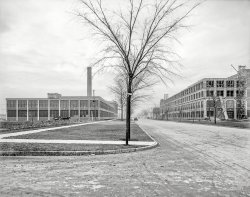
MAY CONTAIN NUTS

Search Shorpy
SHORPY ART

Framed or unframed, desk size to sofa size, printed by us in Arizona and Alabama since 2007. Explore now.
Join and Share
Ad-Free Shorpy
Shorpy is funded by you. Patreon contributors get an ad-free experience.
Learn more.

Recent comments
- Ticket Retention
- Killed by Amtrak
- Back to the Future
- Heckuva remote control!
- Sometimes — Things Go Bump!
- I SEE THE LIGHT
- Union Switch and Signal Company
- Get That Light Out Of My Eyes
- Eggs. Eggs. Eggs. The Egg Man is Here!
- Foreboding caption
- Famous Hollywood faces
- Not just S&P
- re: Those things in the jar
- Up In Smoke
- Medical Smoking
- Quick fix
- A Quink Comment
- If You’re Like Me, Never
- Delivering the News
- U.S.A.
- S&P
- 1940 Zenith radio model 6G601
- Quality goes in before the name goes on!
- Snazzy skirt
- Carbon Arc Lamps
- Illuminate us
- I remember it well
- I can't prove it
- Complicated then, forgotten now
- Bryan-Stevenson
Member Photos
The Shorpy
Print Emporium
Print Emporium
Search Shorpy
Search results -- 30 results per page
- Dime Bank: 1911
- Detroit, Michigan, circa 1911. "Dime Savings Bank building under construction." 8x10 inch dry plate ... trucks and electric trucks on the roads. Below, an ad from 1911. - Dave]
Working the steel I'm not sure if I could handle working ... Posted by Dave - 07/29/2012 - 10:14am -
![Dime Bank: 1911 Detroit, Michigan, circa 1911. "Dime Savings Bank building under construction." 8x10 inch dry plate glass negative, Detroit Publishing Company. View full size.
CompetitionLooks like the crew on the left has a one story lead over the crew on the right.
The ornate rooftop at lower left was Detroit's old City Hall, demolished in 1961. But the Dime Building is still there. Happy centennial, Dime.
Current LookThe beautiful Penobscot building replaced the smaller building on the far left of the photo 15 years later, sitting nicely next to the tallest building on the left edge of the photo, the Ford Building.
View Larger Map
MaterialsHard to imagine that everything on that building was hauled there by horse teams and freight wagons! Sure would like to see some SHORPY photos of that procedure.
[Don't forget trucks. By 1910 there were thousands of motor trucks and electric trucks on the roads. Below, an ad from 1911. - Dave]
Working the steelI'm not sure if I could handle working on those stage platforms like those guys that are cladding the structure.
What is the process here? Is it concrete, brick or some other rendering over the steel.
It sure is a handsome building.
ConstructionThe steel insides don't seem all that different from contemporary construction, but it's shocking to see the lower unfinished levels - airy and open with all that massive (granite?) density above. With older buildings I tend to believe the that the external skin is structural even if I know better and this messes with that illusion.
Margaret Bourke-White (1904-1971)Would have been only seven years old in this year, but I'm sure this vista would have inspired her immensely. Her late 30's Chrysler Building gargoyle picture still gives me vertigo!
(The Gallery, Detroit Photos, DPC)](https://www.shorpy.com/files/images/4a24411a.thumbnail.jpg)
- Scrambling for Pennies: 1911
- New York, November 1911. "Scramble for pennies -- Thanksgiving." Before Halloween came into its ... Posted by Dave - 09/11/2011 - 8:35pm -
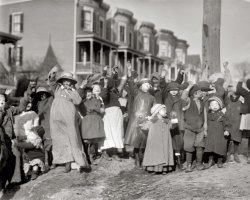
- A Thrill a Minute: 1911
- June 13, 1911. The Cake Walk at Luna Park on Coney Island. View full size. 5x7 glass ... Posted by Dave - 06/25/2009 - 10:00am -
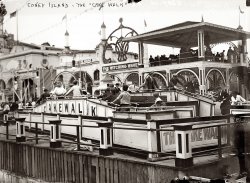
- The Spinning Room: 1911
- March 1911. Magnolia, Mississippi. "Magnolia Cotton Mills spinning room. See the ... Speaking of lamps, electric lamps were still pretty new in 1911. If I'm not mistaken, that was just a few years after Nikola Tesla joined ... Posted by Dave - 02/19/2008 - 9:52am -
![The Spinning Room: 1911 March 1911. Magnolia, Mississippi. "Magnolia Cotton Mills spinning room. See the little ones scattered through the mill. All work." View full size. Photograph (original glass negative) and caption by Lewis Wickes Hine.
Spin FactoryJust looking at the picture makes me want to put on noise canceling headphones. Imagine the din and the Mississippi summer to come. The people and those children had to have damaged hearing among other maladies. I once visited an Industrial Revolution Era knitting mill somewhere in Michigan, it was operated as a museum, and part of the tour was a switch being thrown and the machinery went into action, we were warned about the noise and they only ran it for a few seconds. To have to work an entire day in that racket had to be a danger to their mental and physical health. Again, so much for the good old days.
AftereffectsI was a nursing home social worker in rural Alabama in the early 90s, and most of the residents were former employees of West Point Pepperell Mills in town. One woman stands out in my memory. She was in her 80s, deaf, S-shaped spine and bent over nearly double but still walking. Her sharper-minded neighbors reported to me that Mrs. M. had worked in the mill from childhood onward, and that she was bent over because her job was to pick (something, they had a slang word for everything there) off the floor as a child and her spine didn't develop properly. Likely deaf from the racket in there. Her mind was not together any longer, but she showed me how to fold towels in a "double E" as she did for the mill. I still fold them that way!
How did they manage mentally? In that community, family ties were very strong and church was extremely important. They cherished their time at home and church. People very literally took solace in the belief that their reward was coming.
What is that thing on her head?Can anyone identify the white thing on top of the person's head who is standing between the rows on our right side, directly next to the hanging incandescent lamp? Speaking of lamps, electric lamps were still pretty new in 1911. If I'm not mistaken, that was just a few years after Nikola Tesla joined George Westinghouse at Niagara Falls to produce alternating current. I wonder if the power to drive this equipment was electric motors or would it have possibly been steam?
[She's wearing a bonnet. Incandescent lighting, at first using direct current, goes back to the 1870s. - Dave]
(The Gallery, Factories, Kids, Lewis Hine)](https://www.shorpy.com/files/images/05456u.thumbnail.jpg)
- Eleventh Avenue Freight: 1911
- Mounted flagman and freight. Another circa 1911 view of the Eleventh Avenue rail line in New York near West 26th Street. ... in 10 years", the New York Times wrote on May 4, 1911!!! Because of the New York Central freight railroad which was using the ... Posted by Dave - 09/08/2011 - 7:20pm -
![Eleventh Avenue Freight: 1911 Mounted flagman and freight. Another circa 1911 view of the Eleventh Avenue rail line in New York near West 26th Street. View full size. George Grantham Bain Collection. The light spot at the top is from deterioration of the emulsion.
Death AvenueWell ... Eleventh Avenue was called Death Avenue...!!!
"2000 killed in 10 years", the New York Times wrote on May 4, 1911!!! Because of the New York Central freight railroad which was using the Eleventh Avenue!!! I guess the mounted flag man is the direct consequence of such a dangerous avenue!! Thank you for these great documents!!! I appreciate also the cable car of the first avenue in Little Italy!
-----------------------------------------
Funimag, the web magazine about Funiculars
http://www.funimag.com
Funimag Blog
http://www.funimag.com/photoblog/
[Also known as !!th Avenue. - Dave]
11th Ave.I enjoy these daily visits to the past immensely, they give me the perspective I need in my daily life.
Uneeda BiscuitI love the sign on that building. I need a biscuit...
Street sweeperI like the street sweeper in the background. He looks like the man on the Bullwinkle cartoons.
Uneeda"It's the Uneeda Biscuit made the people wanna go, wanna go, wanna get up and go!" Uneeda Biscuit, first packaged biscuit produced. One of the first mass produced consumer items in America.
(The Gallery, G.G. Bain, Horses, NYC, Railroads)](https://www.shorpy.com/files/images/02884u_0.thumbnail.jpg)
- Yale Varsity Eight: 1911
- ... Click here for more vintage rowers.
June 22, 1911. "Yale rowing team." 5x7 inch glass negative, Bain News Service. View ... Posted by Dave - 09/21/2020 - 11:43am -
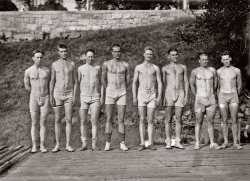
- Cover Nipper: 1911
- October 1911. South Framingham, Massachusetts. Joseph Frank Nugent, 22 Howard Street, ... Posted by Dave - 04/22/2008 - 1:05am -
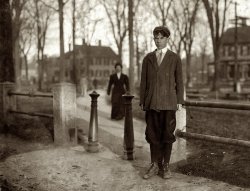
- Letterbox: 1911
- Washington, 1911. "Post Office Department mail box." In front of the Old Post Office ... Posted by Dave - 09/11/2011 - 8:16pm -
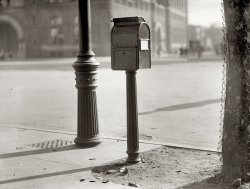
- Grant Park: 1911
- Chicago circa 1911. "Grant Park, south from Art Institute." 8x10 inch dry plate glass ... points out, most of the Michigan Avenue buildings from the 1911 photo still stand.
The tower in the far distance at the left of the 1911 photo is Central Station (demolished 1974). The view looking north from ... Posted by Dave - 08/07/2014 - 5:17pm -
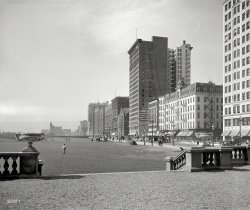
- The Car Factory: 1911
- Detroit circa 1911. "Boulevard view, Packard auto plant." At least two laborers are hard at ... classy, but legal. So this photo has to be earlier than 1911. Want to know more, visit www.LeatherLicensePlates.com
Packard ... Posted by Dave - 09/28/2014 - 4:36pm -
![The Car Factory: 1911 Detroit circa 1911. "Boulevard view, Packard auto plant." At least two laborers are hard at work in our second look at the expansion of Albert Kahn's factory from two stories to four, at the spot where a bridge was eventually built over Grand Boulevard, connecting this building with one across the street. View full size.
Interesting PlateIt looks like the license plate number was painted on the radiator of that car. Was this a common practice?
[Or "license number," since there is no plate. - Dave]
Bryant and Detwiler Contractor There can be no question that Albert Kahn, John Bryant and Ward Detwiler (Bryant and Detwiler Contractors, Detroit) helped shape the greatness Detroit had achieved at its peak. Arguably, Kahn and Bryant/Detwiler were a team: Kahn would design and Bryant /Detwiler would build many of the great buildings that once graced Detroit’s landscape.
License on the radiatorMichigan started with official license plates in 1910. From 1905-1910 the auto owner had to provide his own plates based on a number assigned by the state. This motorist opted to paint his number in bold and sloppy lettering across the radiator. Not classy, but legal. So this photo has to be earlier than 1911. Want to know more, visit www.LeatherLicensePlates.com
Packard plant todayhttp://www.youtube.com/watch?v=hvTwY6tPf4k
A youtube link to a drone tour through the remains, with a MoTown tune to view by.
It pains me bad to think that one of America's finest autos used to roll out of there, and today it looks like a bombed-out 35 acre war zone.
What I wouldnt give to see it operating in its heyday.
The look of industrial AmericaThis plant is so typical of industrial buildings in the first half of the 20'th century, reinforced concrete columns and floors with wall gaps filled in with brick or glass. They were efficient in the use of steel, trading low steel use for high labor costs for forming, pouring, stripping, etc.
This style of construction was especially appropriate for WWII factories when steel was needed by the war effort and concrete and brick were more readily available.
As structural steel became less expensive and more plentiful and labor costs increased for the forming and pouring over the years, structural steel structures with steel curtain walls replaced this style of building in America in the 1950's. The style continued on much longer in Europe and the Eastern Block.
Today it is very rare to see a new cast in place reinforced concrete building in America.
Kahn's work was not limited to rectangular layout factories like the Packard plant. He was also very capable of designing "people" buildings that were functional and very good looking.
(The Gallery, Cars, Trucks, Buses, Detroit Photos, DPC, Factories)](https://www.shorpy.com/files/images/SHORPY-4a21336a.thumbnail.jpg)
- Prep Champs: 1911
- Washington, D.C., circa 1911. "Georgetown basketball." Georgetown Preparatory School junior varsity. ... Posted by Dave - 07/23/2012 - 6:46pm -
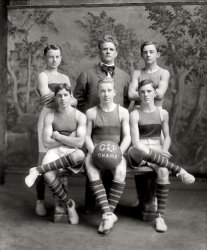
- Ewen Breaker: 1911
- ... Breaker, Pennsylvania Coal Co., South Pittston. January 1911. Spooky full image. Photograph by Lewis Wickes Hine.
"Breaker ... WOJCIECHOWSKI WAS KILLED IN A ROCK FALL IN THE EWEN IN 1911..LEAVING A WIDOW AND 6 CHILDREN.
GRANDSON JOSEPH ... Posted by Dave - 06/09/2018 - 3:23pm -
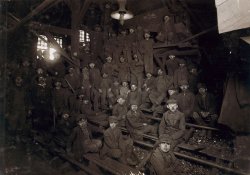
- And Now a Word From Our Sponsor: 1911
- Atlantic City circa 1911. "Bathing in front of the Traymore." As well as giant billboards ... Posted by Dave - 10/18/2012 - 8:36am -
![And Now a Word From Our Sponsor: 1911 Atlantic City circa 1911. "Bathing in front of the Traymore." As well as giant billboards advertising various products both funct and defunct. 8x10 inch dry plate glass negative, Detroit Publishing Company. View full size.
Kondo & Co.Kondo & Co. Importers of General Japanese Goods. Stores:
No. 6 West 33rd St., N. Y. City.
218 Oliver Ave., Pittsburgh, Pa.
1031 Boardwalk, Atlantic City.
1543-45 Boardwalk, Atlantic City.
The Oriental Economic Review, November 10, 1910.
Kondo & Co., who own one of the most prosperous shops in Atlantic City, was founded by Sajuro Kondo, who came to Atlantic City in 1896 from Boston, Mass., as a representative of Yamanaka, Amano & Co. He opened a shop of his own in 1900, beginning with a capital of only $1,600, and has achieved his present very positive success by the sheer force of his business acumen.
A night scene of this section of the boardwalk at Shave Yourself: 1910 where the signage at 1543-45 Boardwalk is "The Tokio." I can't figure out which of these photos came first.
Vaniman's airshipGood contemporary summary of the Vaniman Akron disaster here. More recent word is that the exhaust valves meant to decrease chances of explosion of hydrogen airships may have contributed to the disaster 15 min into its transatlantic flight 1000-2000ft aloft, killing 5 people.
"See Shredded Wheat made"Well, that's the height of Edwardian excitement, I guess; a far cry from the entertainment offered in Atlantic City these days. I bet those large signs built on frameworks were all lit up at night.
See Shredded Wheat MadeNow THAT'S entertainment!
Vaniman's AirshipThe sign advertising "The Wreck of Vaniman's Airship" dates the photo to after July 2, 1912.
Shredded Wheat Fans Unite!I am the only creature in my house that buys and eats shredded wheat. Those biscuits must be properly splattered with milk or they'll go soggy on you. It takes years to perfect the perfect technique but the effort is well worth it. I would give anything to see it made up close and personal. Oh, the Bucket List just keeps growing!
The bride of 40 years, the kids and the grandkids think I'm nuts but what do they know?
Must askWhy is the Gillette sign facing one way in the daytime photo and the other way in the nighttime photo brought to our attention by stanton_square? Has the sign been moved?
[It's also facing the other direction in this one. - tterrace]
Smoke 'Em If You Got 'EmHelmar is Ramleh spelled backwards. Ramleh or Ramla, is a city founded in the Eighth Century. Egyptian cigarettes were deemed more exotic than other Tailor Mades (as opposed to rolling your own). Attached is a WW1 Era ad flacking the smokes to be sent to our boys in uniform. Cigarette advertisements, highlighting Service Men and Women, were also popular during WW2. The Army 'K' Rations (meals ready to eat) contained a four pack of popular brand smokes.
Million Dollar PierIn the background is John Young's Million Dollar Pier, seen here, here, here and perhaps best of all here.
(The Gallery, Atlantic City, DPC, Swimming)](https://www.shorpy.com/files/images/SHORPY_4a25625a.thumbnail.jpg)
- A Bad Lot: 1911
- May 1911. Fries, Virginia. A part of the spinning force working in the Washington ... chewing gum. The company was bought by William Wrigley in 1911.
Giveaways Too bad the Zeno company didn't give away shoes. I ... Posted by Dave - 05/12/2008 - 2:51pm -
![A Bad Lot: 1911 May 1911. Fries, Virginia. A part of the spinning force working in the Washington Cotton Mills. Group posed by the overseer. All work. The overseer said, "These boys are a bad lot." All were alive to the need for being 14 years old when questioned. View full size. Photograph and caption by Lewis Wickes Hine.
B-b-b-bad to the BoneThe boy with the Zeno cap probably received it as a giveaway from the Zeno Manufacturing Co., maker of chewing gum. The company was bought by William Wrigley in 1911.
GiveawaysToo bad the Zeno company didn't give away shoes. I don't know how these boys worked in mills and walked through the rubble outdoors in bare feet. I notice through so many pictures of this era how many dirty, barefooted children there were. I don't think I would have made it.
["Of this era," and all the eras before it. Shoes and baths for children are, historically and generally speaking, recent developments. - Dave]
Pop. 614The 2000 Census showed 614 (I think) people living in Fries, which basically died when the mill closed in the 1970s. I'm from that area and it is seriously in the middle of nowhere down in Western VA/NC border. They have this picture on a web page.
FriesI asked a local how you pronounce the name of the town: is it "fries" or "freeze"? The local joke is that it's "fries" in the summer, and "freeze" in the winter!
(The Gallery, Kids, Lewis Hine)](https://www.shorpy.com/files/images/02074u1_0.thumbnail.jpg)
- Rubberneck Auto: 1911
- New York circa 1911. "Grant's Tomb. Rubber-neck auto on Riverside Drive." To your left, ... Posted by Dave - 08/01/2012 - 5:48pm -
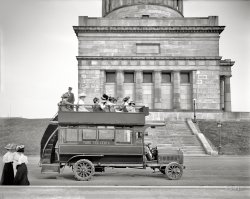
- Northwestern High: 1911
- Detroit, Michigan, circa 1911. "Northwestern High School, main corridor." 8x10 inch dry plate glass ... Posted by Dave - 07/29/2012 - 10:12am -
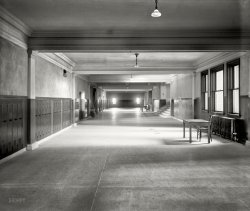
- Willie the Nipper: 1911
- January 1911. Willie Bryden holding the door open while a trip goes through. View ... had overhead trolly lines for electric mine motors. In 1911 they didn't have electric in the mines???????? The mule hats don't make ... Posted by Dave - 09/08/2011 - 12:58pm -
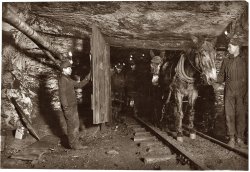
- The Wild, Wild East: 1911
- Atlantic City, New Jersey, circa 1911. "Savoy Theatre, Schlitz & Young's hotels." 8x10 inch dry plate glass ... Posted by Dave - 08/24/2011 - 1:23pm -
![The Wild, Wild East: 1911 Atlantic City, New Jersey, circa 1911. "Savoy Theatre, Schlitz & Young's hotels." 8x10 inch dry plate glass negative, Detroit Publishing Company. View full size.
Re: I'm Freaked OutOh, good. I saw too many '50's sci-fi flicks without my mom's permission
and she always warned me they'd warp my brain.
Best-dressedI must say, the young woman all decked out in classic riding habit at the center is stylin' indeed. Complete with riding crop*, useful should that chap get fresh.
*You can easily make out the handle in her hand, but as she's swinging it slightly, the rest is blurred and blends in with the folds of her skirt.
I'm freaked outWhat the devil IS this?
[Two saddles. - Dave]
For the fairer sex Ladies' side-saddles to be exact.
On the sideNeat! I'm a side saddle rider and I always scan any photo with horses for a glimpse of side saddles or ladies riding aside. Cool to see a side saddle in its original time.
The lady is most likely holding a "hunt whip," which is different from a crop. Hunt whips have an L-shaped handle, usually made of antler, which is handy for hooking onto gates to open them without dismounting. The lash of the hunt whip is used to control the hounds on a hunt.
Weird that the two side saddles that freaked out Rip seem to be "for hire." Riding side saddle is not something you can just hop and and do without some training.
Boardwalk EmpireIs that Nucky Thompson looking out the hotel window?
(The Gallery, Atlantic City, DPC, Horses, Swimming)](https://www.shorpy.com/files/images/4a25632a.thumbnail.jpg)
- Coney Island Orphans: 1911
- Orphans going to Coney Island (Luna Park). June 7, 1911. View full size. George Grantham Bain Collection.
CONEY IS ... and happy, wet as all of them were."
June 8, 1911, Thursday Page 11, 1004 words
NY Times Archive
[If the cockles ... Posted by Dave - 09/07/2011 - 5:43pm -
![Coney Island Orphans: 1911 Orphans going to Coney Island (Luna Park). June 7, 1911. View full size. George Grantham Bain Collection.
CONEY IS CAPTURED BY AN ORPHAN ARMY5,000 Youngsters from City Institutions Have Their Annual Motor Outing to Resort.
DAY'S REVEL AT LUNA PARK
310 Volunteer Automobiles Provide the General Joy Ride -- Children Bedraggled, but Happy.
If the population of New York's orphanages and child-caring institutions had been made up of adults instead of immune and undamagable youth there would be no less than 5,000 cases of adult indisposition to-day, ranging all the way from cold-in-the-head to pneumonia as a result of the seventh annual outing of the New York Orphans' Automobile Association, which took that number of orphaned children for an all-day's excursion in the pouring rain to Luna Park yesterday. As it was, however, when the youngsters motored luxuriously back to their parentless homes there wasn't a complaint or a sneeze or a headache or even a case of popcorny indigestion among them. Every one was hoarsely talkative and happy, wet as all of them were."
June 8, 1911, Thursday Page 11, 1004 words
NY Times Archive
[If the cockles of your heart need warming, click the link and read the entire article. Nothing like hot cockles, I say. - Dave]
Nerdy detailThis truck has chain drive.
(The Gallery, Cars, Trucks, Buses, G.G. Bain, Kids, NYC)](https://www.shorpy.com/files/images/09438u.thumbnail.jpg)
- Cleared for Takeoff: 1911
- Washington, D.C., or vicinity circa 1911. "Flights and tests of Rex Smith plane flown by Antony Jannus." Aviation ... Posted by Dave - 05/22/2011 - 3:17am -
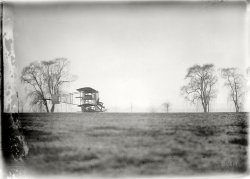
- The Way Old Ballgame: 1911
- 1911. Washington, D.C. "Professional baseball -- view during game." The ... of a wayward plumber's blowtorch before the start of the 1911 season. The concrete and steel replacement on the same site didn't get ... Posted by Dave - 01/10/2012 - 8:24am -
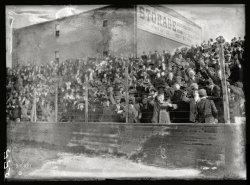
- When We Were Young: 1911
- District of Columbia, 1911. "Negroes. Negro life in Washington." Harris & Ewing Collection glass ... Posted by Dave - 08/22/2012 - 8:37pm -
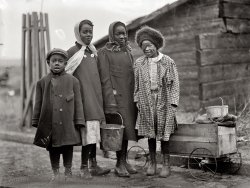
- The Old P.O.: 1911
- The Post Office building in Washington circa 1911, about the closest the District of Columbia ever came to having a ... Posted by Dave - 08/23/2012 - 3:31pm -
![The Old P.O.: 1911 The Post Office building in Washington circa 1911, about the closest the District of Columbia ever came to having a skyscraper. Harris & Ewing. View full size.
AD 1897Notice the "AD 1897" over the door; it was about 14 years old at the time.
Taxi, anyone?The three cars in the foreground may be taxis. Is that a fare box in front of the window on the middle one? I also notice that the people just walk wherever they want in the streets. They have sidewalks but do not feel motivated to use them.
The grandest of them all!Seems like government or public architecture in the period this building was built used the same box of parts. Town Halls, schools and post offices all looked very similar. But I have never seen anything approach this in scale. It surely must be the grandest of them all! The life span of these buildings was relatively short. Was it because conversion to newer heating/cooling systems was impractical?
Car vs driverThese cars have the look of horseless carriages.
I'm surprised that the manufacturer saw fit to provide a roof over the head of the driver, since they didn't make any other concessions to the comfort of the person operating the thing.
[That's the town car body style -- open driver's compartment, enclosed passenger compartment. - Dave]
UnthinkableThere was a move at one time to tear this wonderful building down! Cooler heads prevailed!!
Railway Post OfficeThe white blur in front of the building is a Pennsylvania Avenue railway post office, or R.P.O. The streetcars in Washington as well as several other cities that carried mail and no passengers were painted white. Mail was sorted by a clerk in the car. Letter mail received en route was postmarked aboard the trolley and dispatched to post office stations located near the route.
The "old post office" building served two roles. The offices at street level and above were the Post Office Department headquarters. The building also served as the main post office for the District, with retail windows through the doors up the steps at the front, and a workroom floor in the core of the building and below street level. Loading docks were at the rear for city deliveries as well as wagons to the railway stations.
The mail processing activities and main post office functions shifted to a new building at 2 Massachusetts Avenue N.E. after Union Station was opened. The Post Office headquarters relocated to a new building across the street to the right in this view, completed in 1932.
Frank R. Scheer
Railway Mail Service Library
Cheer, cheer for old Notre DameIt was designed by Willoughby J. Edbrooke, the same architect who designed the Golden Dome at Notre Dame.
Go visit it!The building is still there--and not only that, the Post Office Pavilion building is open for visitors. The ground floor has a few retail shops and restaurant vendors. Or you can take 2 separate elevators up to the bell tower and look at the beautiful view of Washington. All free too. http://www.oldpostofficedc.com/
(The Gallery, D.C., Harris + Ewing)](https://www.shorpy.com/files/images/13335a.thumbnail.jpg)
- Blitzen Benz: 1911
- May 25, 1911. Bob Burman and his " Blitzen Benz ," a month after setting a world ... Posted by Dave - 12/10/2007 - 5:38pm -
![Blitzen Benz: 1911 May 25, 1911. Bob Burman and his "Blitzen Benz," a month after setting a world speed record in the car. View full size. George Grantham Bain Collection.
Is today's picture brought to us by the letter B?Did Bob Burman race his "Blitzen Benz" at Brighton Beach?
Was his wife Barbara in the audience? Were his parents, Brunhilde & Barnard, at the finish line?
Up too late last night,
mad4books
Spidey?Does he not look just like Tobey Maguire?
Was his wife's name reallyWas his wife's name really Barbara? I think not
Racer XTo go with the earlier Speed Racer post.
Can't you see the speedlines?
Bob BurmanAt the time Burman set that official speed record, he was the fastest man in the world. Only a bullet or cannon shell was faster - he was twice as fast as any existing airplane, and no locomotive could go faster, either. It was a unique record.
Bob, Brunhilde, Bernard, Barbara BurmanBob's parents were not Brunhilde & Bernard, they were Frances and William. Bob's wife's name was not Barbara. He had two wives, the first Lulu, and the second Helen. I don't believe that either of his parents saw him race out of state, but I'm not sure of that.
[You are still Not Getting It. - Dave]
Wife and parentsHis wife was not Barbara (he had two wives in his lifetime), and his parents, were not Brunhilde & Barnard. I don't believe his parents ever saw any of his races out of state. But that I can't be sure.
[Clueless Comment of the Day! Clapclapclap. - Dave]
(The Gallery, Cars, Trucks, Buses, G.G. Bain, Sports)](https://www.shorpy.com/files/images/09237u.thumbnail.jpg)
- The Elms of Academe: 1911
- Circa 1911. "The College Green -- Burlington, Vermont." 8x10 inch dry plate glass ... Posted by Dave - 05/15/2021 - 1:20pm -
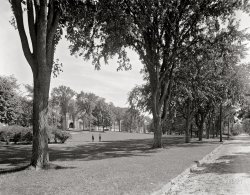
- Indian Orchard Mills: 1911
- ... was working. Indian Orchard, Massachusetts. September 1911. Uncropped full image.
Pipe smoker I love the kid smoking the ... Posted by Dave - 07/27/2012 - 9:47am -
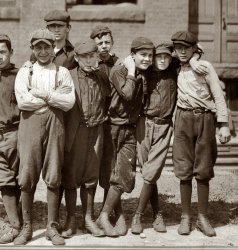
- Two Cents' Worth: 1911
- Detroit circa 1911. "Dime Savings Bank under construction." A preliminary look at the ... The small car behind the horse appears to be a 1911 Hupp-Yeats electric. They were manufactured in Detroit.
Historic link ... Posted by Dave - 11/20/2014 - 11:29am -
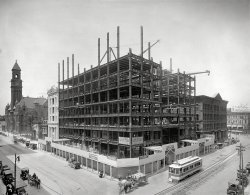
- Chicopee: 1911
- November 1911. Chicopee, Massachusetts. "Group of workers in Dwight Manufacturing Co. ... Posted by Dave - 09/29/2008 - 9:06am -
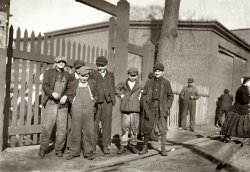
- Boy in Mudville: 1911
- January 1911. Pittston, Pennsylvania. "Tom Vitol (also called Dominick Dekatis), 76 ... Posted by Dave - 02/07/2011 - 10:22am -
![Boy in Mudville: 1911 January 1911. Pittston, Pennsylvania. "Tom Vitol (also called Dominick Dekatis), 76 Parsonage Street, Hughestown Borough. Works in [coal] Breaker #9. Probably under 14." Photograph and caption by Lewis Wickes Hine. View full size.
What's With That?Two names? Good thing Dave didn't find this photo first or our favorite photo site might have been called Vitol-Dekatis.
No need for colorThis is one of those pictures that I suspect would look pretty much the same taken with color film. The dreariness of the scene is accented by the contrast between the tight focus on Tom/Dominick and the soft focus of the surroundings. Very eloquent photograph.
One of those coincidences'Twas only yesterday, literally, that I re-read "Casey at the Bat", whence the origin of the pun "Boy in Mudville."
And nowThis was taken at the back of 76 Parsonage Street. The houses at the back are on Miller Street.
View Larger Map
Wipe those feet!Googling the location I think I found one or two houses that might be this one. The street does look bleak. According to a real estate listing, 105 has been fixed up nicely, on the market for $129,000. Pittston is apparently dying.
(The Gallery, Kids, Lewis Hine, Mining)](https://www.shorpy.com/files/images/01141u.thumbnail.jpg)
- Packard Plant: 1911
- Detroit circa 1911. "Boulevard view, Packard auto plant." Expansion of the Albert ... Posted by Dave - 09/25/2014 - 9:49am -
